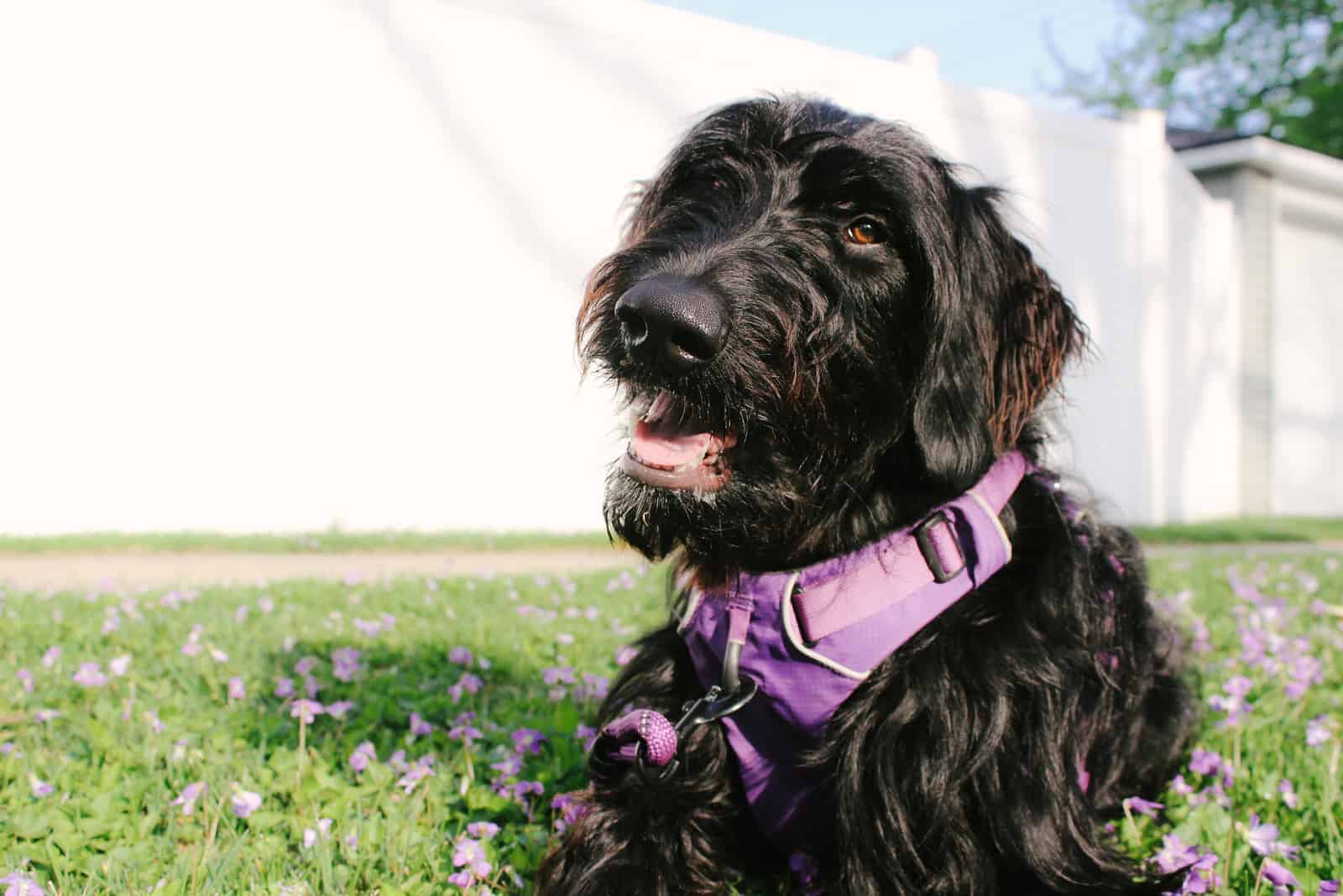What’s not to love about Goldendoodles? These adorable little pups look like living Teddy Bears! They are cute, they are fluffy, and they have adorable personalities!
When you think about Goldendoodles, you usually imagine dogs that have golden or apricot coats, and look as cheerful as possible! However, not many dog lovers are aware that Goldendoodles come in many colors. Yes, there are even black Goldendoodles!
When people see Goldendoodles with a black coat, they usually confuse them with Labradoodles. As black Labrador Retrievers are somewhat common, black Labradoodles are not a big deal.
However, Black Goldendoodles are a whole different story.
A crossbreed between a purebred Poodle and a Golden Retriever, it is standard for Goldendoodles – also known as Groodles – to come in coats that range between yellow and chocolate. They usually come in gold-yellow or cream as the Golden Retriever’s genes highly influence their coat color.
However, other colors are possible due to a large number of Poodle colors available. Still, due to genetics, dark colors, especially black, can be hard to find.
So, what is it that makes black Goldendoodles so special? We’ll dive in to help you meet these amazing and unusual dogs, and let you know more things about them.
Can Goldendoodles Be Black?
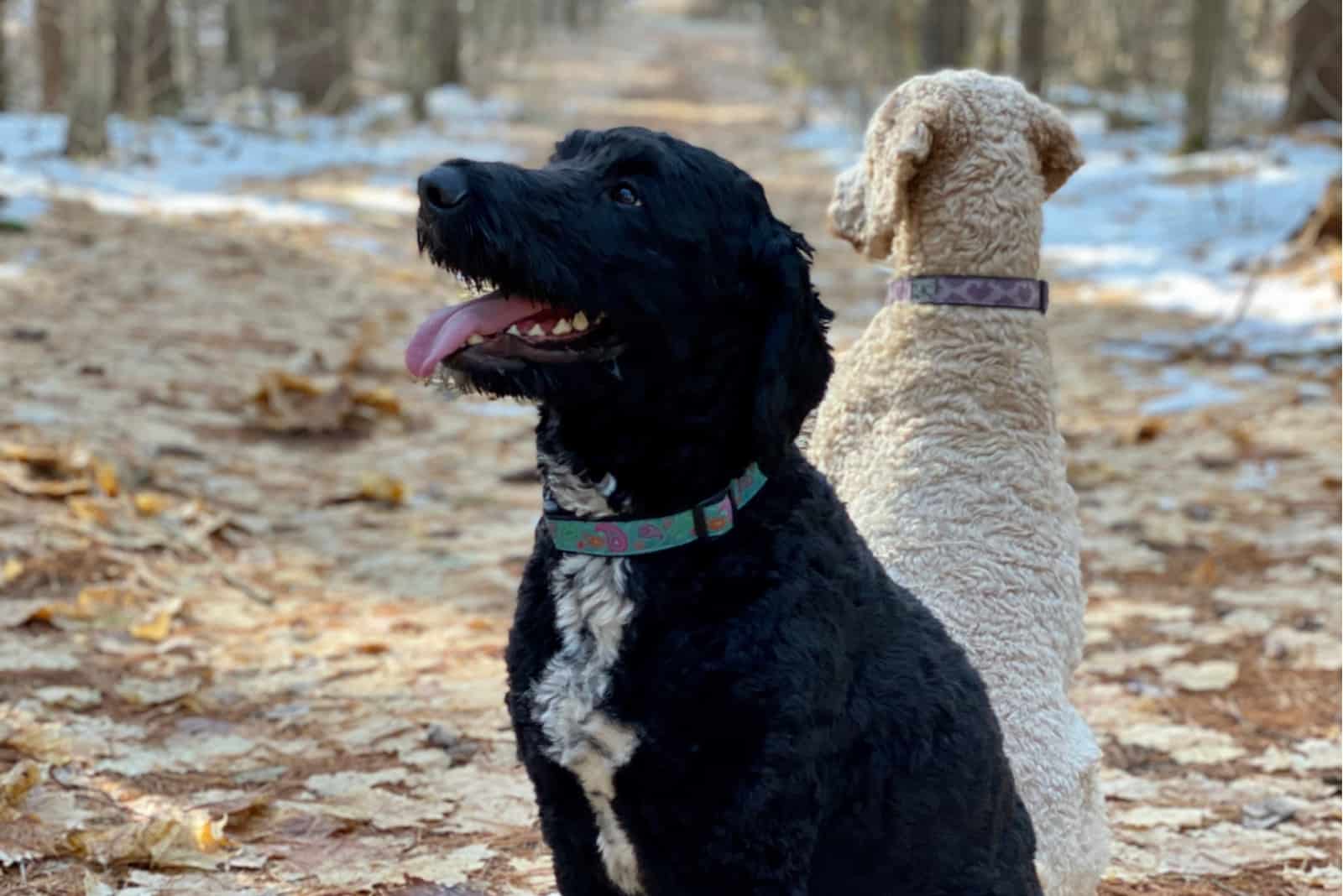
Yes, Goldendoodles can be black. In fact, they can come in any color that Poodles come in. This includes white, gold, chocolate, and even parti or sable!
However, as their name would suggest, most breeders focus on producing yellow or cream Goldendoodles. In the end, it is this loving and royal color that sets them apart from other Doodles, such as Labradoodles, Bernedoodles, or Great Danoodles.
This doesn’t mean that black Goldendoodles don’t exist. They simply aren’t as popular as other lighter Goldendoodle colors.
It’s important to keep in mind that Goldendoodles, just like any other designer breed, aren’t recognized by large kennel clubs, such as the American Kennel Club (AKC).
As such, you don’t have to worry about a color following the breed standard as there isn’t one – at least not a regular one, but we’ll explain this a bit later. All Goldendoodle colors are good colors as long as they are up to your liking.
Are Black Goldendoodles Rare?
Yes, black Goldendoodles are relatively rare. There aren’t many breeders who specialize in breeding Goldendoodles of this color.
Most breeders will simply end up with a few black Goldendoodles in a litter by accident instead of focusing on breeding them. As such, chances are you can find more black Goldendoodles at a shelter than to buy them from reputable sources.
The main reason behind this is demand. Most people looking for Goldendoodles want dogs that come in beautiful golden or cream colors.
However, as the years go by, the demand changes as well. People seem to love rare dog colors once the breed (or a mixed breed) stops being entirely new, so chances are black Goldendoodles will become more common over time.
Overall, most black Doodles that look like Goldendoodles are, in fact, Labradoodles. Other than the coat color (and this can overlap as well) and sometimes the coat length, these two crossbreeds look almost exactly the same.
Black Goldendoodle Genetics
Goldendoodles can come in any color their parent breeds come in. Due to the Golden Retriever genes, they’ll mostly come in cream, apricot, and red.
Not just that, but this is the color that most people want Goldendoodles to come in, and breeders are there to listen to the demand. This is another reason why this color isn’t easy to find.
Golden Retrievers come in red colors only (cream, apricot, and golden are all considered a variation of red color). As such, the black coat color comes from the Poodle side.
In the case of Poodles, black is a recessive gene. This means that a Goldendoodle puppy needs to inherit the black color gene from both its parents. As Golden Retrievers will rarely have that gene in them, this means that the first generation of Goldendoodles will rarely produce black Doodles.
It’s important to note that there is more than one gene that determines the coat color. Some genes are also connected with the coat type and cause a straight coat or a wavy coat.
As such, it is challenging and nearly impossible to determine what the type and color of your Goldendoodle puppy will look like until the puppy is older.
One thing is certain, though. Unless the Golden Retriever has some black genes in his genetics – and with purebred dogs, this is nearly impossible – the first-generation designer dog won’t have a black coat.
Goldendoodle Breed Standard
We’ve already mentioned that unlike most dog breeds, crossbreeds aren’t recognized by major kennel clubs. This includes not just the AKC, but the UKC and the FCI as well.
However, Goldendoodles have existed since at least the 1990s. This gave people plenty of time to understand what a Goldendoodle is supposed to look like. As such, many Goldendoodle breeders are attempting to create a breed standard that will help give an overview of what this designer breed is supposed to look like.
As such, the Goldendoodle Association of North America (GANA) actually created a breed standard a few years ago. All breeders who’d like to be a member of the GANA must now follow this standard and help give the breed the appearance it’s supposed to have.
Just like in a purebred dogs’ breed standard, the Goldendoodle breed standard covers the dog’s appearance (including the coat color and type) and temperament.
For example, Goldendoodles can come in these sizes:
As for the colors, the GANA’s standard lists five Goldendoodle coat colors:
• Cream
• Apricot
• Red
• Chocolate
• Black
As such, black Goldendoodles can be accepted by the GANA as they are up to the breed standard.
Black Goldendoodle Full Grown Size
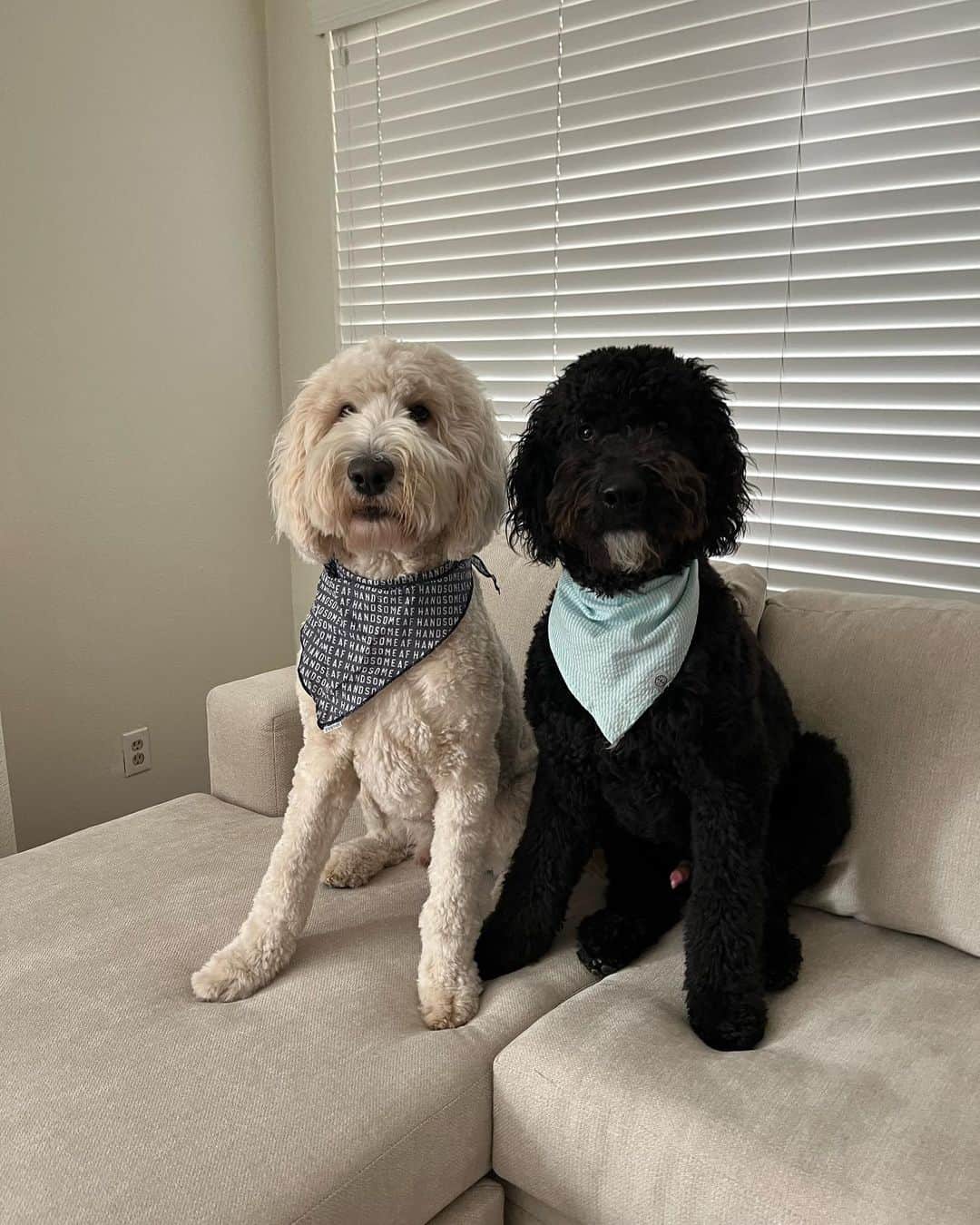
Photo from: @doods_of_olympus
It is challenging to fully predict how big a mixed breed dog will be. This is because a puppy can reach the height of any of his parents, or he can be somewhere in between.
Usually, Goldendoodles are created by crossbreeding a Golden with a Standard Poodle. This is the best option as there are not many surprises when it comes to the dog’s size.
When it comes to other sizes, they can be rather unpredictable in not just the first generation, but even more so in the second due to many recessive genes that might have gone unexpressed.
As such, to get mini Goldendoodles, for example, most breeders decide to create a backcross by breeding a Goldendoodle of small size with a mini Poodle. This is also a great way to give a puppy more hypoallergenic properties.
Black Goldendoodle Puppy
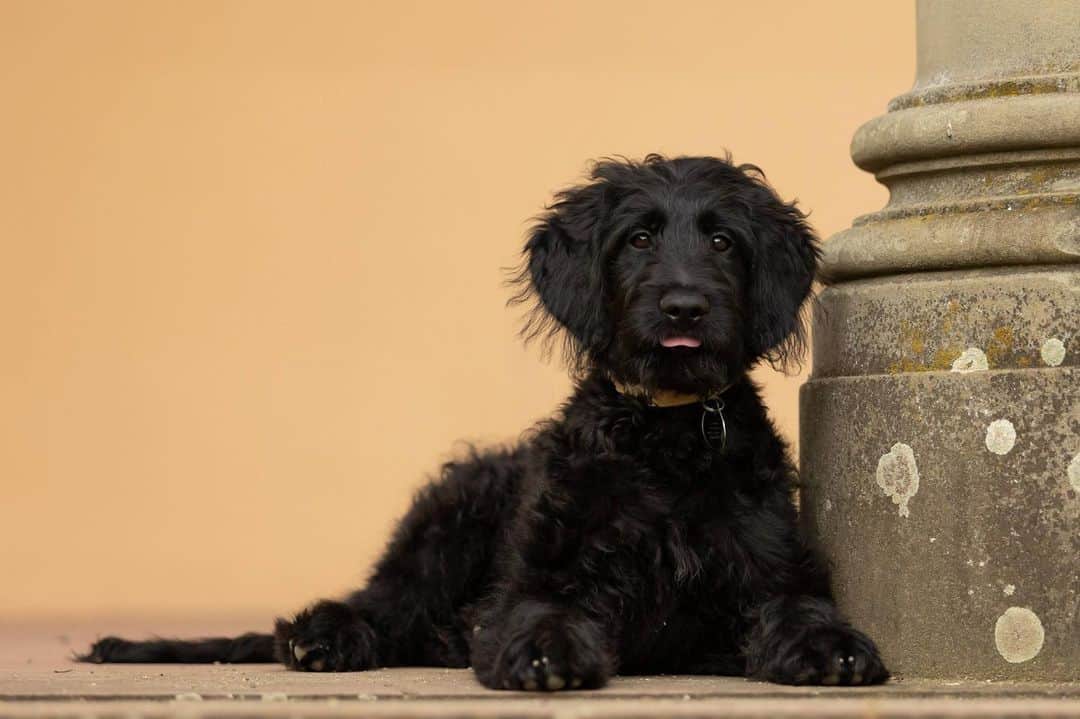
Photo from: @lady_fluffalot
As we’ve mentioned, black Goldendoodle puppies are hard to find. If a breeder wants to sell black Groodle puppies, they should mate a Goldendoodle that has a black Poodle parent with another black Poodle, or with a Goldendoodle with the same genetics.
This will increase the chances of puppies inheriting the black coat gene from both parents.
Sometimes, black Goldendoodle puppies can be born by accident. This happens if both the Poodle and the Golden Retriever parent have a recessive black gene hidden inside their genetic pool.
However, this almost never happens as purebred Golden Retrievers won’t have any black genes.
Black Goldendoodle Mini
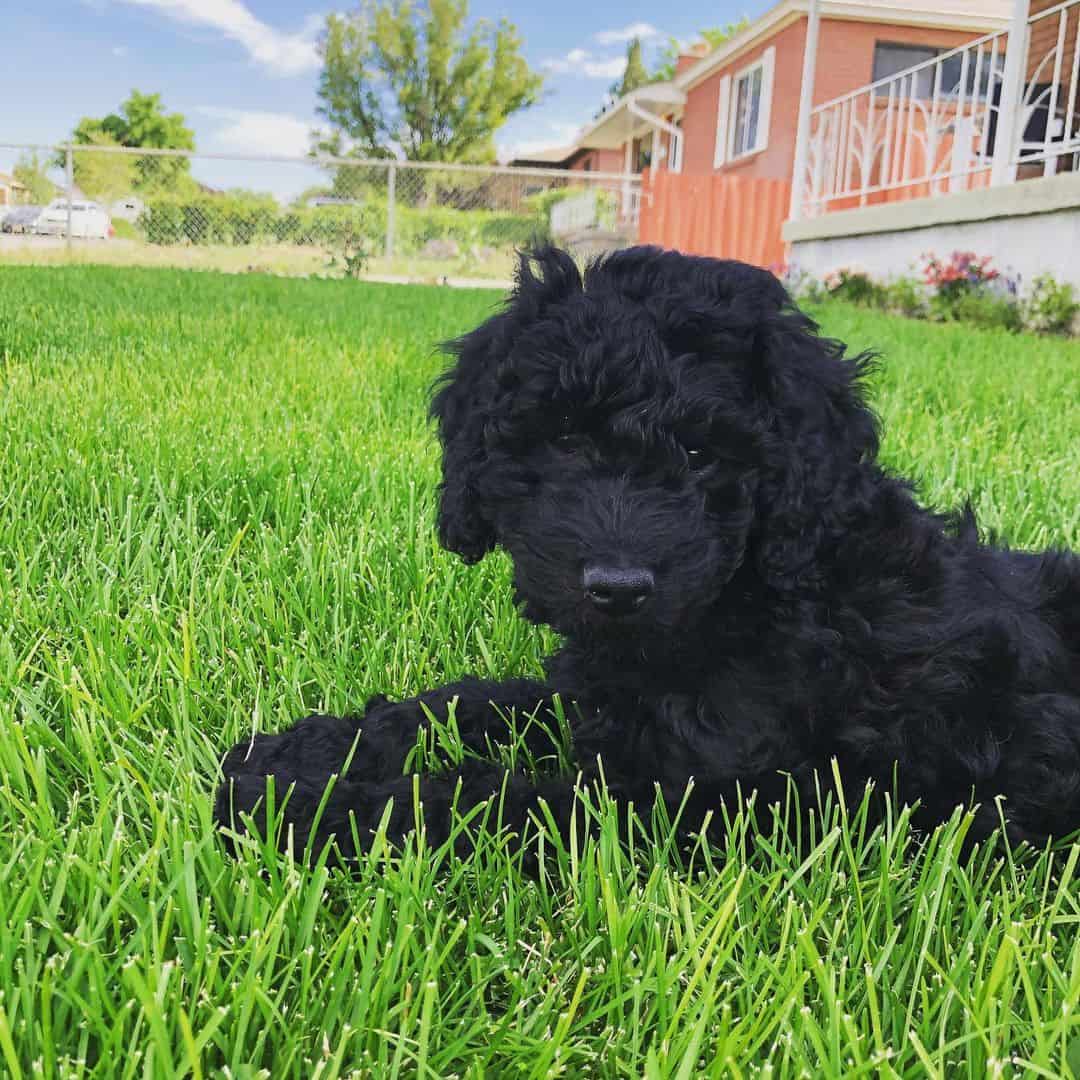
Photo from: @phoebe_thecutestdoodle
Mini black Goldendoodles are a crossbreed of a Golden Retriever and a mini black Poodle. They can be somewhat challenging to find as due to the Golden Retriever’s size, it can be challenging to ensure the puppies will stay small.
As such, it’s essential to only buy mini black Goldendoodles from reputable breeders. Many irresponsible breeders will breed runts of the litter or puppies with dwarfism to ensure a larger number of mini black Goldendoodle puppies.
Responsible breeders will usually sell mini black Goldendoodles that aren’t first generation as these can ensure a higher percentage of small puppies.
Black Goldendoodle Generations
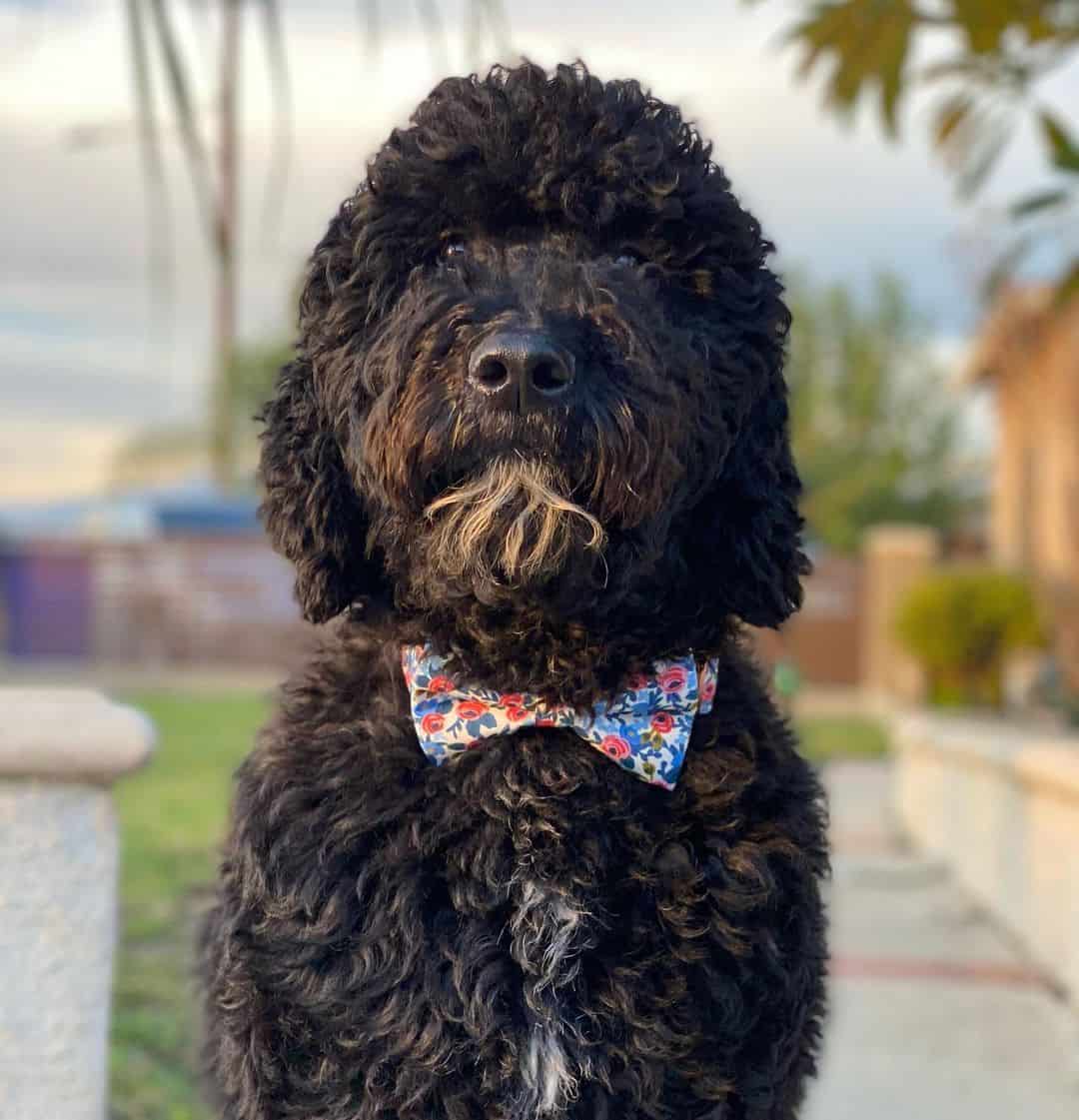
Photo from: @roxy_blackdoodle
Crossbreeds aren’t produced the same way as purebred dogs are. In fact, most are created by crossbreeding two parents of different breeds. In the case of Goldendoodles, these parents are the Golden Retriever and the Poodle.
However, you might also get a mixed breed dog by breeding two crossbreeds together. While this isn’t a popular practice, it is a great way to get some unique colors and types of coat, such as black Goldendoodles.
We’ll explain.
Black Goldendoodle F1
F1 Goldendoodles are the first generation of crossbreeds. This means that their parents are a purebred Poodle and a purebred Golden Retriever.
However, as mentioned before, this generation of crossbreeds will rarely result in a black Goldendoodle. Golden Retrievers will share dominant genes for red color, and the black color won’t show on the dog’s coat without adding some more recessive genes into the mix.
Black Goldendoodle F2
F2 Goldendoodles are a second generation of Goldendoodles. To produce them, breeders will mate two Goldendoodles together.
To ensure the black coat color, breeders must carefully monitor the dog’s parents. As F1 Goldendoodles will rarely come in black, the breeder has to be familiar with its genetics in order to know which dogs to pair.
If both Goldendoodle parents have genes for a black coat, the chances of a black puppy being born are around 50%.
Black Goldendoodle F1B
F1B Goldendoodles are the most common generation when it comes to black Goldendoodles. This is because it’s easier to predict the puppy’s features when you create a backcross.
To get F1B Goldendoodles, it’s necessary to take an F1 Goldendoodle with genes for a black coat color and further breed it with a black Poodle.
As black Poodles have two genes for the black coat, the chances of a black F1B Goldendoodle being born are around 75%. This is much higher than with the first and the second generation.
Black Goldendoodle F3
F3 Goldendoodles, or multi-generation Goldendoodles, are created when you mate an F2 Goldendoodle with an F1 Goldendoodle.
Multi generations, whether we’re talking about F3 or even F4 Goldendoodles, are much easier to predict appearance-wise than younger generations.
However, some unpredictable accidents can happen as you can never be entirely sure as to what hidden genes your dog has picked up.
This is why most breeders don’t want to mess around with multigen Goldendoodles. Instead, they’ll focus on creating backcrosses.
Black Goldendoodle Colors
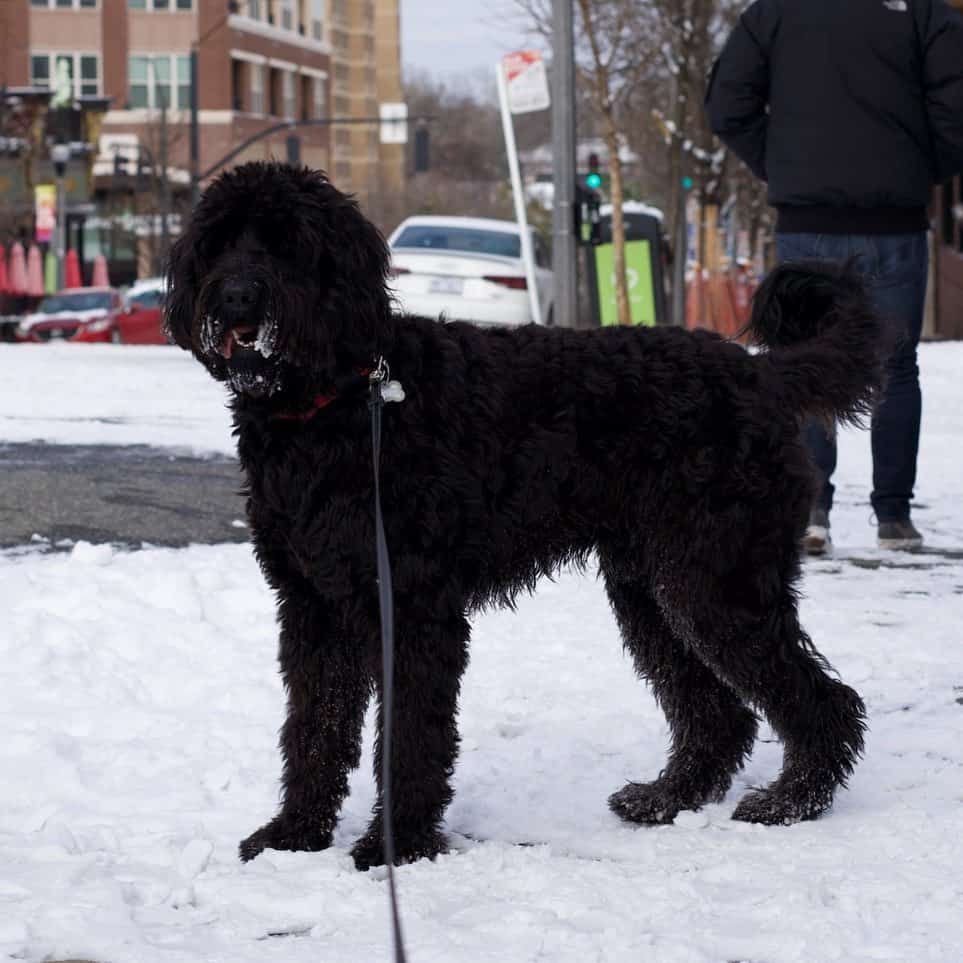
Photo from: @drizzdoodle
Black Goldendoodles don’t just come in one shade. In fact, they can come in several shades and patterns.
If you’re looking for black Goldendoodles, here are a few color combinations you might run into:
Solid Black Goldendoodles
Solid black Goldendoodles are extremely rare to find. Most Goldendoodles have at least a patch of white color. Solid dogs can have none.
This is likely the rarest variation of black Goldendoodles. While Poodle genes allow solid-colored puppies, this is rare when you’re dealing with a recessive color.
Some people would argue that only solid black Goldendoodles can actually be considered black. However, this would only further lower the number of black Goldendoodles out there.
Not just that, but any Goldendoodle with even a patch of the black coat has to carry a recessive black gene. Genetically speaking, these Goldendoodles are black in color.
Goldendoodle Black And White
Black and white Goldendoodles are the most common variation of black Goldendoodles. White usually comes in the form of a white patch on the dog’s chest or stomach, but it can sometimes be as small as just a speck.
Black and white Goldendoodles are still rather popular, especially as they are less likely to change shade as they grow older.
Black And Cream Goldendoodles
Black and cream Goldendoodles are another common variation. These dogs look the same as black and white Goldendoodles, but with cream patches instead of white.
The cream color usually comes from the Golden Retriever’s side, which is why this pattern might be the perfect way to showcase both parent breeds.
Tri-Color Goldendoodles
Tri-color Goldendoodles are very rare. They are even rarer than solid-colored black Goldendoodles!
These Goldendoodles have a black base, with lighter markings in two different shades. Usually, in Goldendoodles, these shades are cream and white.
A tri-color combination is almost impossible to find in Poodles, which is why it’s a challenge to get tri-color Goldendoodles. As such, this pattern can be extremely expensive and sought after.
Do Black Goldendoodles Change Color?
Black Goldendoodles might change color over time. In fact, many black Goldendoodle puppies won’t grow up to be black Poodles.
Dark brown Goldendoodles can look the same as black Goldendoodles right after birth. It isn’t until a few weeks later that you’ll be able to notice their coat turning lighter in color.
In fact, many Goldendoodles will keep on changing the shade of their coat even into adulthood. However, these changes will rarely be drastic.
Usually, a black Goldendoodle might get a dark grey shade as it gets older. This process isn’t the same as getting grey hairs as this color isn’t connected with your dog getting old.
Some external factors can also cause a dog’s coat to change colors. For example, if a dog has spent too much time in the sun, his coat might temporarily become lighter.
Improper dog food and care can ruin a dog’s health. A dog might not express any sign of an existing health issue, but his coat might become dull and lose its shine. This can often lead to the hairs appearing to be in an entirely different color!
To prevent this from happening, your best option is to take good care of your dog. Most importantly, you need to get him the best dog food possible.
Don’t worry – this doesn’t mean you have to spend lots of money on feeding your dog. There are many good dog food options that you can find on websites, such as Chewy or Amazon at a very low price.
Look for foods rich with omega 3 and omega 6 fatty acids as these nutrients do wonders for the dog’s skin and coat.
You might even replace store-bought treats with some more affordable options you already have at your home, such as brussels sprouts, apples, or pepper.
Black Goldendoodle Grooming
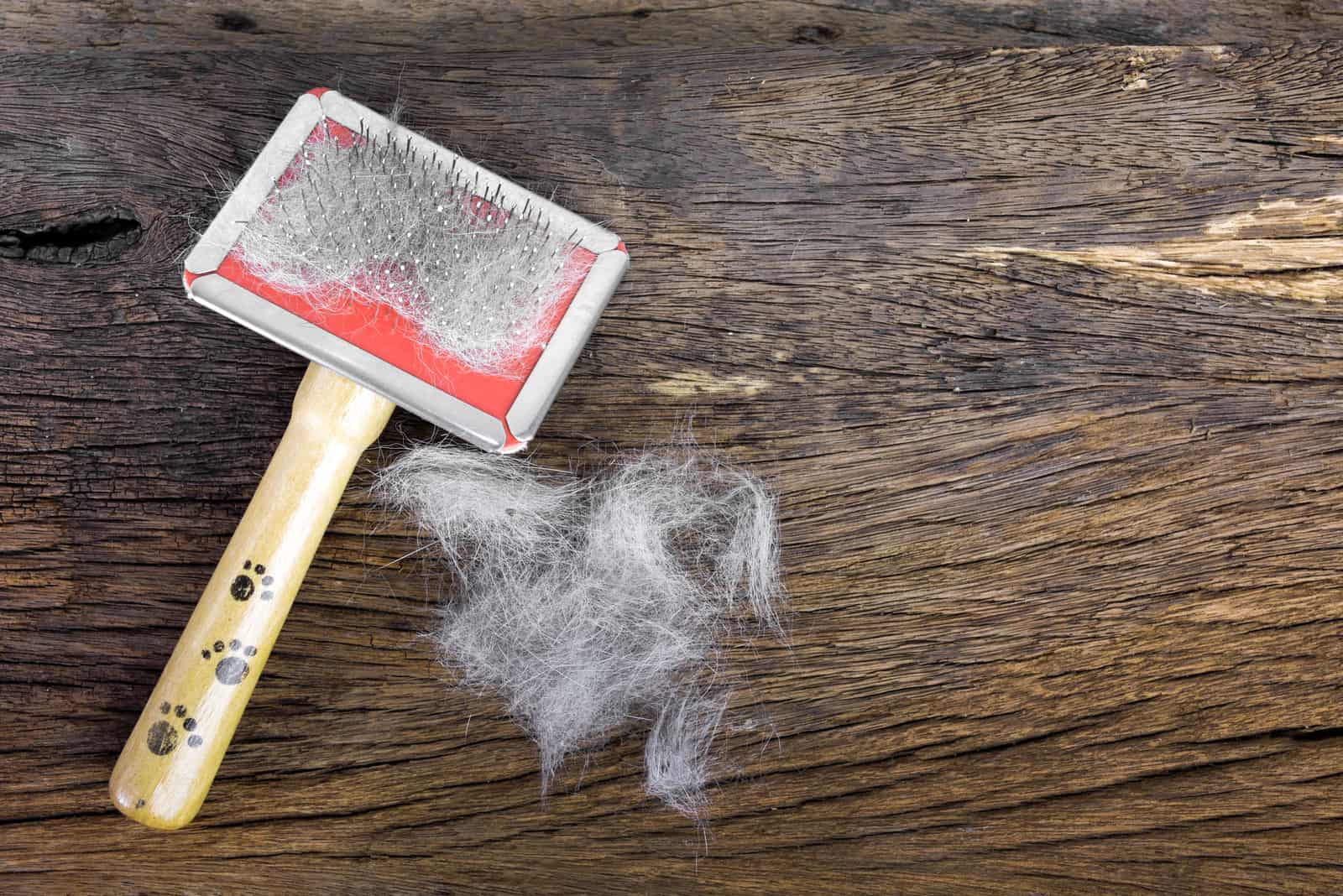
Black Goldendoodles require the same maintenance as Goldendoodles of any other color.
These dogs can have a straight, wavy, or curly coat that requires daily brushing with an adequate brush to keep it from matting and tangling. As such, you could say they do require a little more maintenance than short-haired breeds.
However, a Goldendoodle’s curly coat also means there’s less shedding. As a result, while it’s true you’ll have to brush your dog every day, you won’t have much cleaning to do afterward. For many dog owners, this is a fair trade.
Black Goldendoodle Haircuts
One of the ways to keep a black Goldendoodle’s coat from tangling is to take him to a groomer every now and then. Cutting your Goldendoodle’s locks can help keep the coat from matting, and it can even make your dog feel more comfortable, especially during summertime.
We would never advise shaving your dog’s coat entirely. Hairs have their purpose, and cutting them might disrupt this. Still, there are several Goldendoodle haircuts you might want to try out. Some of the most popular ones are called:
• A Teddy Bear Cut
• A Pom Pom Cut
• A Mohawk Cut
• The Lamb Cut
• The Kennel Cut
It is up to you to choose what type of haircut your Goldendoodle will get. They all have their advantages and virtues. You might want to consult with your vet or a groomer if you’d like for your Doodle to sport some wicked hairstyle.
Is a Black Goldendoodle Hypoallergenic?
Hypoallergenic, whether it’s plastered on a product or used to describe a dog, means that there are no allergens present. However, this isn’t the case with Goldendoodles or any other dog breed.
When it comes to dog allergies, it isn’t dog hair that causes you problems. It’s dander that gets stuck onto it. As the hairs fly around, they’ll get into your nose, spreading allergens.
Next to dander, a dog’s urine and saliva will also cause dog allergies. While there are low shedding dogs, such as Poodles, there are no dogs that produce no urine and saliva.
As such, no dog can be considered truly hypoallergenic. However, Goldendoodles can come close.
If a Goldendoodle has a curly coat, just like its Poodle parent, it won’t shed much. It also won’t drool, so you are more or less safe from having an allergic reaction.
If you struggle with severe dog allergies, your best option might be to get a purebred Poodle or to consult with your doctor about antihistamines.
Black Goldendoodle Puppy For Sale
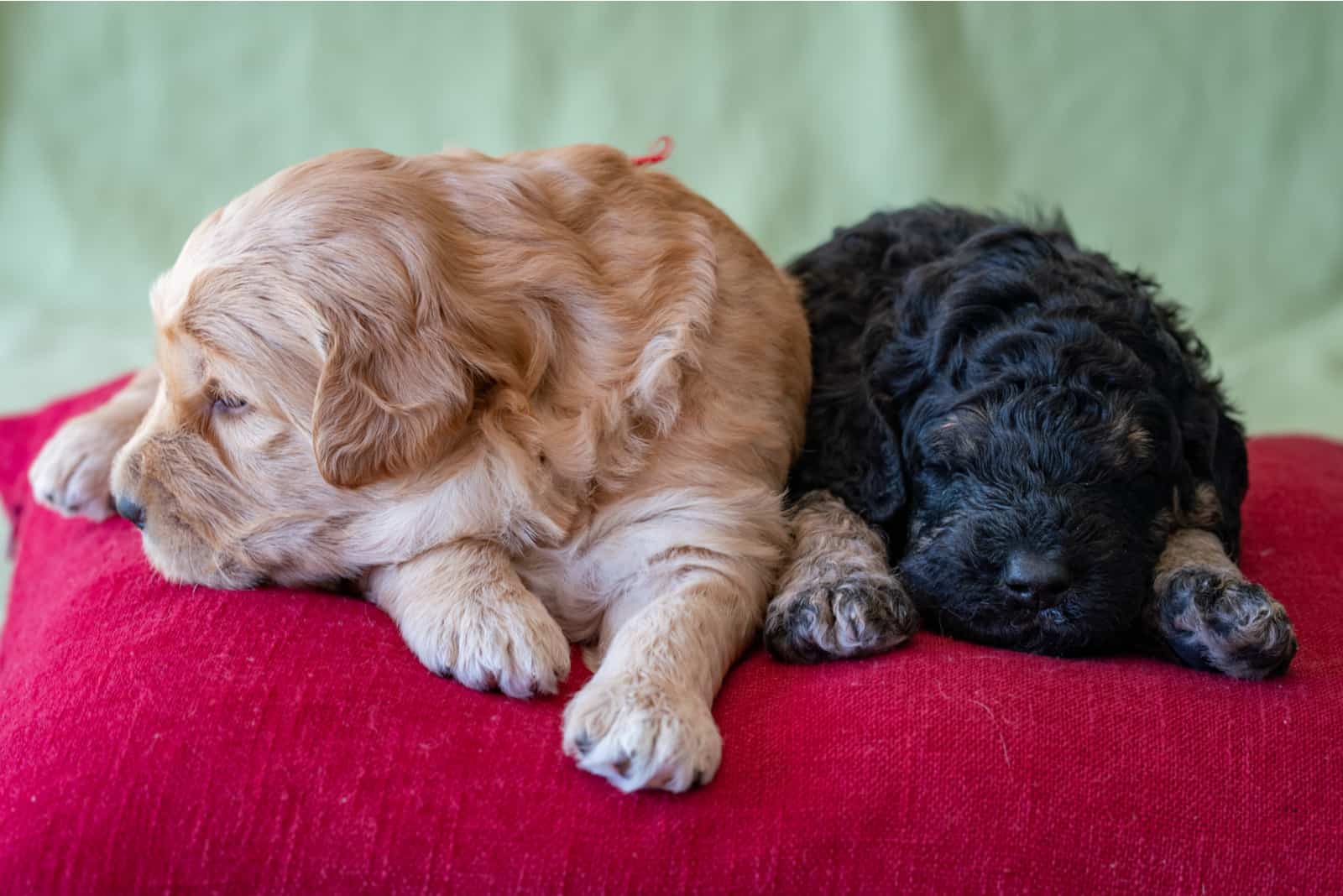
Not many breeders will focus on breeding black Goldendoodle puppies. This isn’t just due to not many people being interested in buying them. This is an unpredictable color, and the only way you can be entirely sure that a dog will be born black is to breed two black Goldendoodles together.
As finding two black Goldendoodles can be tricky, most breeders will simply backcross a Goldendoodle with a black Poodle.
If you’re interested in getting this unique family pet, you might also want to contact local animal rescues. Unfortunately, black Goldendoodles aren’t the most popular dogs, which is why many of them will end up abandoned or left at shelters.
How Much Is A Black Goldendoodle?
Despite the fairly low demand, black Goldendoodles have a high price. This is because they are rare and not easy to produce. As such, you can expect to pay anywhere between $1,500 and $3,000 for this type of dog.
These prices vary depending on the breeder, on the dog’s bloodline, and also on the dog itself. Solid black Goldendoodles will usually cost more than black and white ones.
Coat type can also influence the dog’s price. Poodles can come in many coat types such as curly, corded, or even shaggy coats. The prettier the coat looks, the more expensive the dog will be.
The costs of owning a dog don’t end at the initial price. You should also expect to buy dog food every month, while also buying items and accessories, such as a dog bed and a dog toy.
You should also count on some medical expenses every now and then. While Goldendoodles are healthy dogs, there are some health concerns, such as hip dysplasia. Still, you should never save on vet visits.
Black Goldendoodle Names
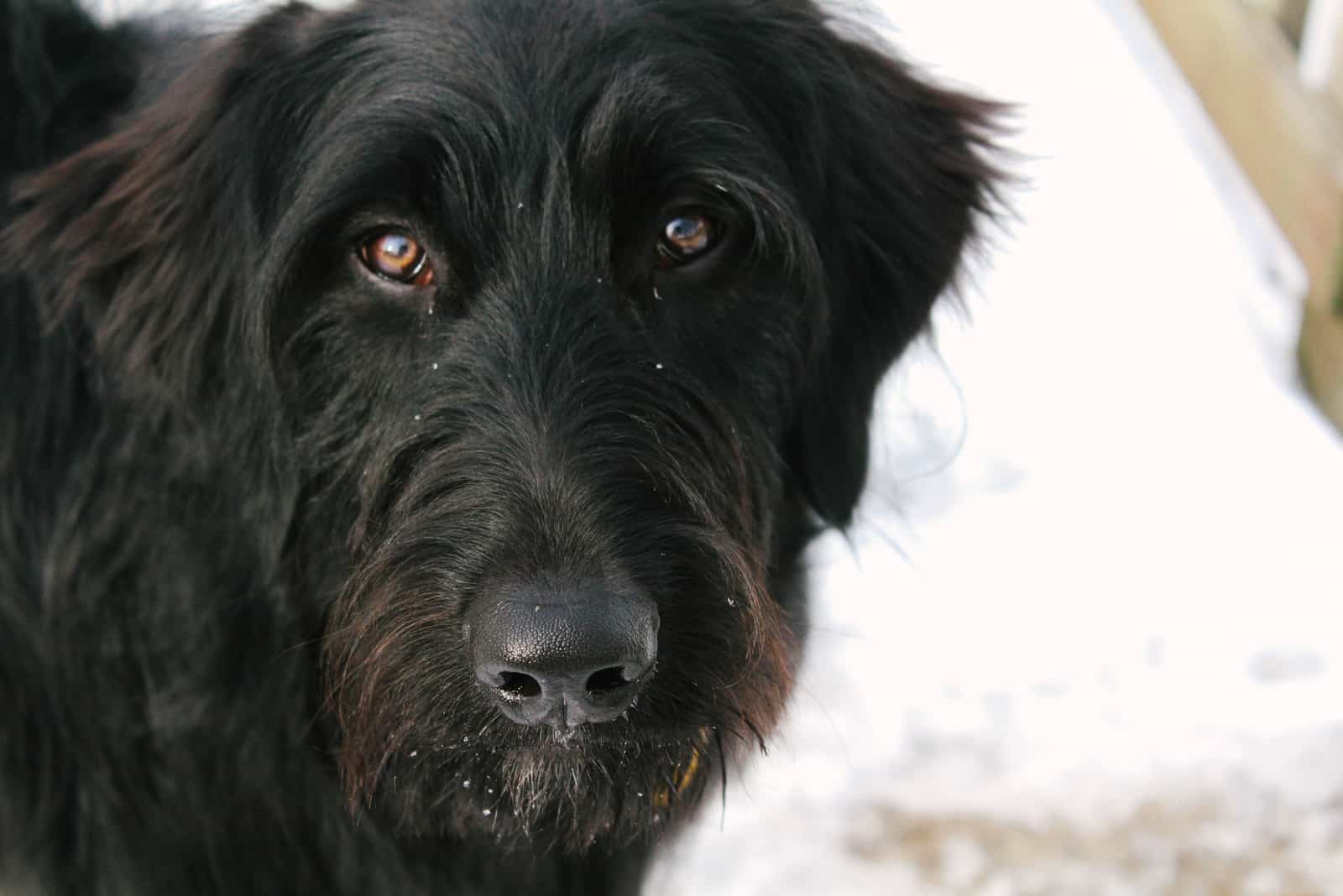
Once you’ve picked up your black Goldendoodle puppy, the next important thing is to choose what you’ll name your new pooch.
The name will matter to you more than it’ll matter to your dog – however, there are some things you need to be wary of.
A good name has to be short and easy to pronounce. While a dog won’t know that a certain word is their name, they’ll understand it as a command to come to you or to look in your direction. As such, you should also make sure your Goldendoodle name doesn’t sound too similar to some common commands, such as sit or stay.
Some good ideas for your black Goldendoodle name include:
• Blackie
• Shadow
• Molasses
• Raven
• Butler
• Moose
• Smokey
• Batman
• Edgar
• Poe
What Is The Difference Between Labradoodles And Goldendoodles?
Many people confuse Labradoodles and Goldendoodles – especially when they come in black color – something uncommon for Goldendoodles.
Here are a few key differences between Labradoodles and Goldendoodles:
The most obvious difference is that while Goldendoodles are a crossbreed of Golden Retrievers and Poodles, Labradoodles are a mix of Poodles and Labrador Retrievers.
• Labradoodles tend to be a bit more playful than Goldendoodles.
• Labradoodles make somewhat better guard dogs, although the differences are minimal.
• Goldendoodles make a bit better family pets, although the differences are minimal.
• Labradoodles tend to come in more colors than Goldendoodles.
• Goldendoodles have a thinner, softer coat than Labradoodles.
Goldendoodles tend to look a bit ‘fluffier’ compared to Labradoodles.
Should You Get A Black Goldendoodle?
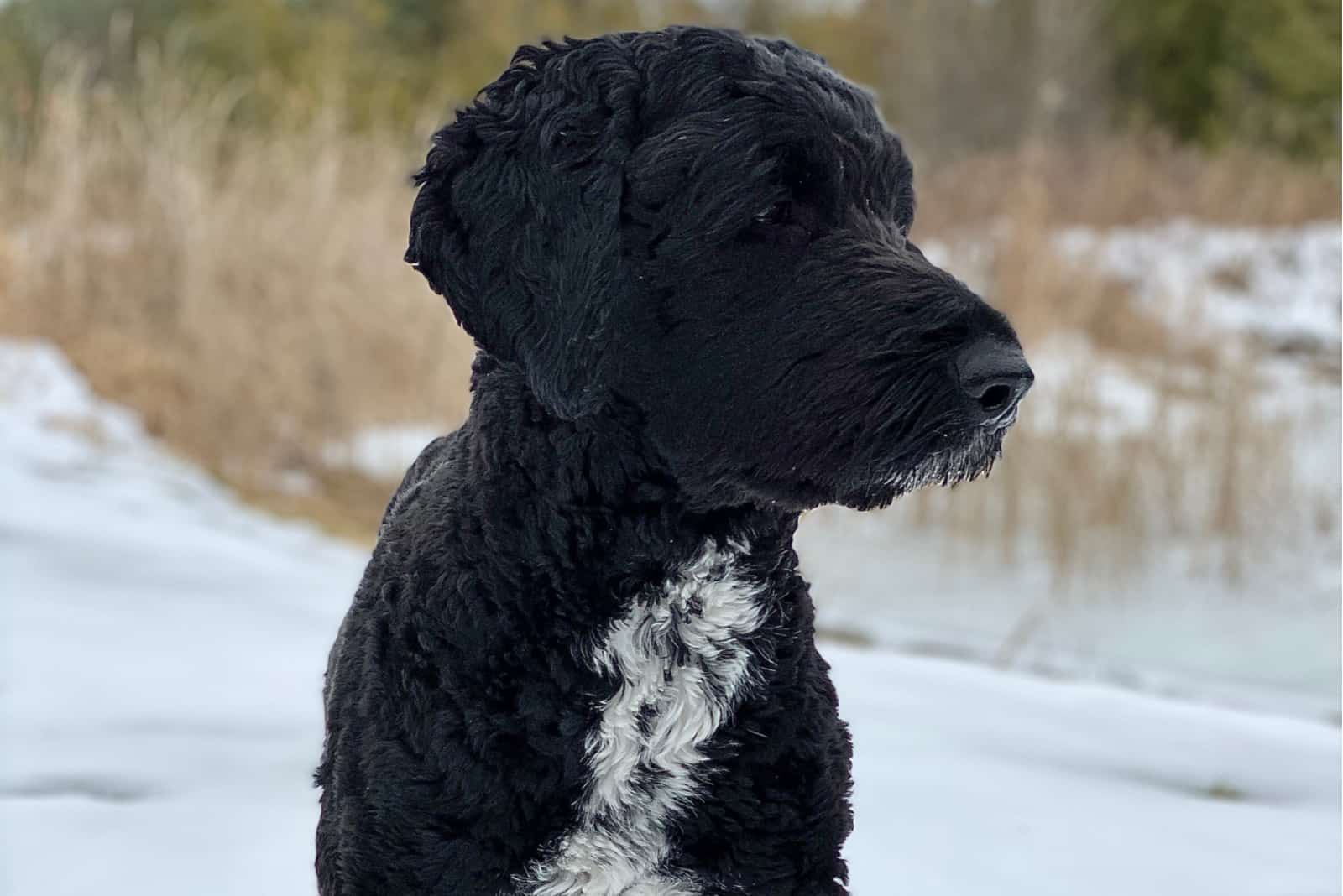
Now that you know all this, should you get a black Goldendoodle as your family companion?
These dogs have adorable, friendly temperaments and cute and unique looks. They can also make great service dogs and therapy dogs, although they won’t do well as guard dogs due to their social nature. In fact, some much smaller dogs, such as Yorkies, will probably make better watchdogs than Goldendoodles!
They have low shedding coats with moderate grooming needs, so they can be easy to maintain while remaining fairly hypoallergenic. As they can come in several sizes, there seems to be one for every type of home!
Overall, Goldendoodles seem to combine the best traits of Poodles and Golden Retrievers – two of the friendliest family pets you can get. As the color doesn’t change anything other than a dog’s appearance, black Goldendoodles can be a great choice for any family.
If you choose a black Goldendoodle as your family companion, you won’t make a mistake.
